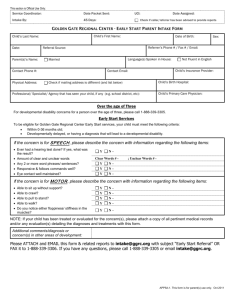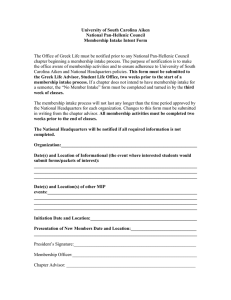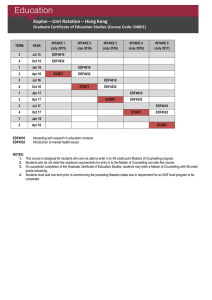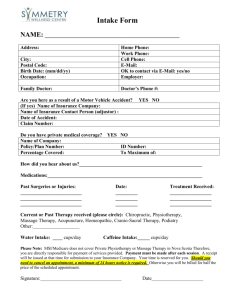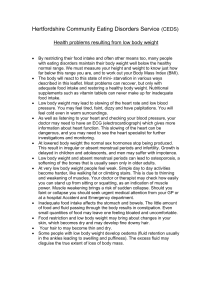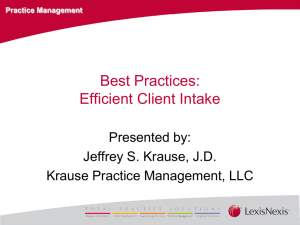TEMPLATES FOR ESTABLISHING A COMMUNICATION TEAM
advertisement
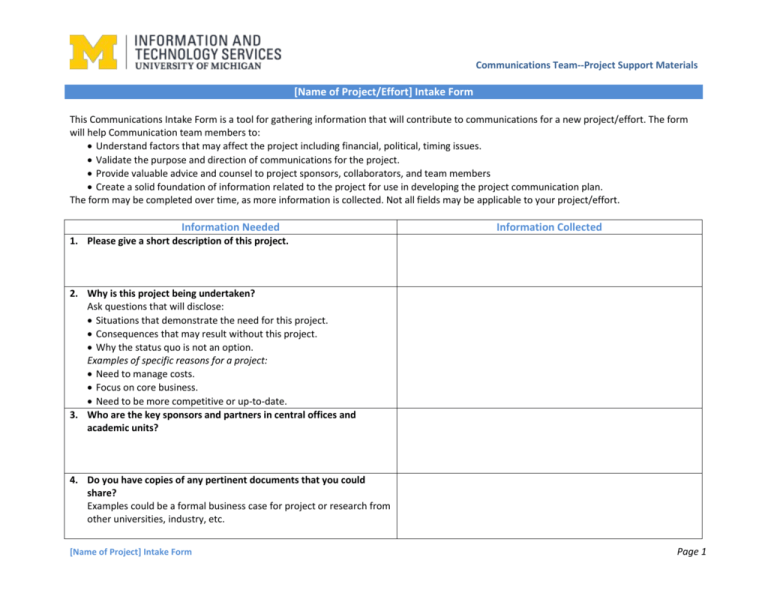
Communications Team--Project Support Materials [Name of Project/Effort] Intake Form This Communications Intake Form is a tool for gathering information that will contribute to communications for a new project/effort. The form will help Communication team members to: Understand factors that may affect the project including financial, political, timing issues. Validate the purpose and direction of communications for the project. Provide valuable advice and counsel to project sponsors, collaborators, and team members Create a solid foundation of information related to the project for use in developing the project communication plan. The form may be completed over time, as more information is collected. Not all fields may be applicable to your project/effort. Information Needed Information Collected 1. Please give a short description of this project. 2. Why is this project being undertaken? Ask questions that will disclose: Situations that demonstrate the need for this project. Consequences that may result without this project. Why the status quo is not an option. Examples of specific reasons for a project: Need to manage costs. Focus on core business. Need to be more competitive or up-to-date. 3. Who are the key sponsors and partners in central offices and academic units? 4. Do you have copies of any pertinent documents that you could share? Examples could be a formal business case for project or research from other universities, industry, etc. [Name of Project] Intake Form Page 1 Communications Team--Project Support Materials Information Needed 5. What do you see as the strengths, weaknesses, opportunities, and threats in relation to the project? (SWOT Analysis): Information Collected Strengths: Weaknesses: Opportunities: Threats: 6. What relevant information do you have about the current environment and history of areas that this project will affect? People’s experiences may influence their response to news of change. Mitigate negative perceptions and bolster positive perceptions by identifying: Key messages. Potential issues or advantages. Political sensitivities that might affect acceptance of the project. 7. What are the business goals for this project? Encourage the project lead/team to articulate specific business goals; such as: Cost savings of $X over X months. Move from manual to automated process over X years. XX% of affected staff to move to new organization. You can also pull this from Project Charters, Workplans, etc. [Name of Project] Intake Form Page 2 Communications Team--Project Support Materials Information Needed 8. What metrics/analytics will you use to determine that project/effort objectives have been achieved? Examples: User satisfaction research/surveys. Web/Email analytics Qualitative feedback (anecdotes, focus groups, etc.) Achieved cost saving of $X Distinguish between measures already in place and measures to be put in place. 9. What is the timing/duration of the project/effort? Information Collected Start: Go-Live: Key Milestones: Completion: 10. What outcomes do you expect from this project/effort, such as potential business and/or customer impact? Consider viewpoints of various stakeholders and users and identify both positive and negative, short- and long-term impacts. Identify key messages for ITS staff to convey to customers. 11. What other components are needed besides project/effort communications that contribute to making this project/effort a success? Examples: Adjustments in quarterly goal setting/accountabilities. Human resources support. New or adjusted systems or processes. Manager availability. This information will also help identify if other Comm team members are needed on the project/effort. [Name of Project] Intake Form Page 3 Communications Team--Project Support Materials Information Needed Information Collected 12. What audiences or groups will be affected by this project/effort— both directly and indirectly? Specifically, what does each group do and how does it relate to the project/effort What is the impact of the project/effort on other parts of U-M, service partners, etc. High Meet Their Needs Get Buy-In & Change Behavior Inform Only Show Consideration INFLUENCE Low Low RISK TO PROJECT High 13. How do these audiences stay informed? Examples: regular meetings newsletters (print or electronic) web sites e-mail 14. In what ways can communications help to achieve the project/effort goals or mitigate some of the anticipated negative outcomes? Acquire information for the detailed communication plan Include communication objectives that are realistic and measurable. Define the level of communications assistance the project/effort team desires. 15. Will this project/effort need internal communications support (e.g. project status reports, allstaff communications, News@ITS articles, Intranet postings). [Name of Project] Intake Form Page 4 Communications Team--Project Support Materials Information Needed Information Collected 16. Do you have a project/effort budget for communications staffing and deliverables? [Name of Project] Intake Form Page 5

